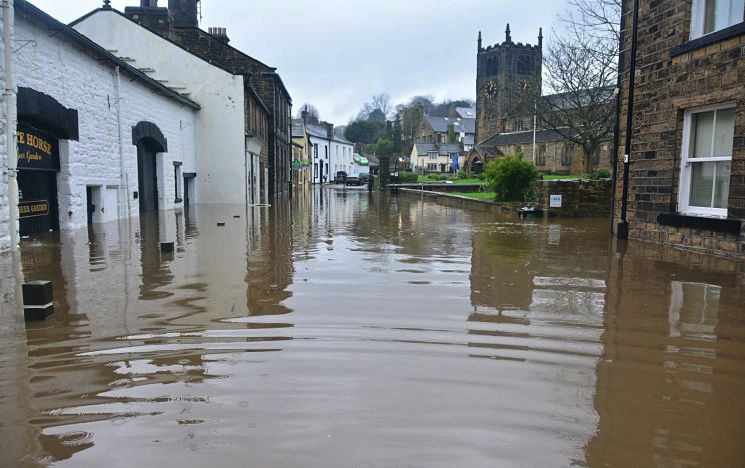How maths can help predict which areas will flood next
Dr Omar Lakkis teamed up with environmental advice company Ambiental to refine a maths equation that calculates flood risks.

Photo by Chris Gallagher on Unsplash
Predicting which areas of land will flood is a tricky business. And it’s a challenge which is going to become more urgent as our planet experiences more erratic weather patterns caused by the climate crisis.
Fortunately, mathematicians are helping us to meet this challenge. Dr Omar Lakkis, a Reader in mathematics at the University of Sussex, has been working with environmental assessment company Ambiental.
The work of Lakkis and his research team enabled Ambiental – which provides advice to government agencies and the insurance industry – to improve its predictions of where flooding would occur.
Lakkis says he was was keen to help Ambiental find a solution.“Flooding is devastating. And in the UK, it is the greatest natural hazard we face. In other countries, people endure earthquakes, hurricanes, tornados or wildfires. For us, flooding poses real peril.
“A UK Government report found that flooding, and managing it, costs the UK about £2.2 billion each year. So accurately predicting where flooding occurs is important both commercially and also to the individuals in those places.”
Before Lakkis began working with Ambiental, they faced a hurdle. Their new code had huge potential, predicting where flooding might occur accurately in 90% of cases. But the remaining 10% eluded them. And these were the most critical cases; the ones lying at either end of the bell curve of expected behaviour. They were often the cases with challenging geographic features, such as a dam or flood gate, which might break suddenly and release millions of tons of water. These are the instances in which flooding would be most catastrophic.
Before Lakkis and his colleagues got involved, Ambiental would have to manually identify each of these cases and run thousands of simulations – changing the input data each time - as a way to calculate a more accurate flood risk. It’s a hugely time-consuming task.
In beginning to collaborate with Ambiental, Lakkis set about researching the problem. The research team used a type of hyperbolic equation called “shallow water equations” but their code simulating this equation broke in 10% of runs. Lakkis and his team found sources of instability in the code and, after analysing it, suggested a cure that would capture "shock waves" without breaking down.
Ambiental added Lakkis’ tweaks into the code and it helped hugely. The codes became more stable, their predictions more accurate and faster to produce. For example, their customers would now have to wait only a month for a report rather than two or three months.
And, while helping a commercial partner to become more efficient is worthwhile, there are greater reasons why the Sussex team’s contributions matter so much.
Speaking to Lakkis, David Martin, who is the Chief Technology Officer at Ambiental, explained: "The risk industry is necessary because it allows the stable operation of critical financial instruments that control, help and stabilise society. They enable society to work in the way that we know it to work. The insurance industry, of course, needs to understand risk. And it's important that they do in a way that allows them to thrive, given an increasing amount of risk and hazard to them, in view of uncertainties like climate change. This can drive positive change.
"That's a good thing for customers: it's better to understand the risk and the sort of impact it can have. If you don't understand the risks, for example, an insurer could end up dismissing a whole postcode because one or two buildings are at risk out of tens, or even hundreds.
"This can have the negative impact of driving up premiums and create wider challenges. So, it's helpful for all to understand the risk, and then to deal with it appropriately, and proportionally.”
Lakkis is now looking at solving new challenges, such as how to predict the impact of rainfall patterns, vegetation cover and climate-change related shifts of patterns on flood risk.
He concludes: “As a mathematician, I like to think that I’m contributing to the world. Often in mathematics, we’re happy to be able to solve a problem, like a Rubik’s cube. We solve it; we’re happy. We often do maths because it’s fun. We like the challenge because it’s difficult not because it's useful. But often solving a maths problems turns out to be also useful.
“I’m very much concerned about our planet and the climate crisis. I cycle to work, I compost food waste – all of these practical things. But until now, I’ve not used my mathematics to improve our life and our prospects. So it was rewarding to be able to use sophisticated mathematics - which I’ve spent many years learning and improving for something so useful as dealing with the weather.”
Contact us
Research development enquiries:
researchexternal@sussex.ac.uk
Research impact enquiries:
rqi@sussex.ac.uk
Research governance enquiries:
rgoffice@sussex.ac.uk
Doctoral study enquiries:
doctoralschool@sussex.ac.uk
Undergraduate research enquiries:
undergraduate-research@sussex.ac.uk
General press enquiries:
press@sussex.ac.uk